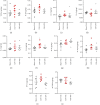Trained Innate Immunity by Repeated Low-Dose Lipopolysaccharide Injections Displays Long-Term Neuroprotective Effects
- PMID: 33061831
- PMCID: PMC7547335
- DOI: 10.1155/2020/8191079
Trained Innate Immunity by Repeated Low-Dose Lipopolysaccharide Injections Displays Long-Term Neuroprotective Effects
Abstract
Disrupted immune response is an important feature of many neurodegenerative conditions, including sepsis-associated cognitive impairment. Accumulating evidence has demonstrated that immune memory occurs in microglia, which has a significant impact on pathological hallmarks of neurological diseases. However, it remains unclear whether immune memory can cause subsequent alterations in the brain immune response and affect neurobehavioral outcomes in sepsis survivors. In the present study, mice received daily intraperitoneal injection of low-dose lipopolysaccharide (LPS, 0.1 mg/kg) for three consecutive days to induce immune memory (immune tolerance) and then were subjected to sham operation or cecal ligation and puncture (CLP) 9 months later, followed by a battery of neurobehavioral and biochemical studies. Here, we showed that repeated low-dose LPS injection-induced immune memory protected mice from sepsis-induced cognitive and affective impairments, which were accompanied by significantly decreased brain proinflammatory cytokines and immune response. In conclusion, our study suggests that modulation of brain immune responses by repeated LPS injections confers neuroprotective effects by preventing overactivated immune response in response to subsequent septic insult.
Copyright © 2020 Xiao-yan Zhou et al.
Conflict of interest statement
The authors declare that they have no conflict of interest.
Figures







Similar articles
-
CD4 and CD8 T Cell Memory Interactions Alter Innate Immunity and Organ Injury in the CLP Sepsis Model.Front Immunol. 2020 Nov 20;11:563402. doi: 10.3389/fimmu.2020.563402. eCollection 2020. Front Immunol. 2020. PMID: 33329524 Free PMC article.
-
Deficiency of alpha-calcitonin gene-related peptide induces inflammatory responses and lethality in sepsis.Cytokine. 2013 Nov;64(2):548-54. doi: 10.1016/j.cyto.2013.07.030. Epub 2013 Sep 8. Cytokine. 2013. PMID: 24021706
-
CD4 T Follicular Helper Cells Prevent Depletion of Follicular B Cells in Response to Cecal Ligation and Puncture.Front Immunol. 2020 Aug 12;11:1946. doi: 10.3389/fimmu.2020.01946. eCollection 2020. Front Immunol. 2020. PMID: 32903485 Free PMC article.
-
Constitutive Vagus Nerve Activation Modulates Immune Suppression in Sepsis Survivors.Front Immunol. 2018 Sep 6;9:2032. doi: 10.3389/fimmu.2018.02032. eCollection 2018. Front Immunol. 2018. PMID: 30237803 Free PMC article.
-
Cecal ligation and puncture: the gold standard model for polymicrobial sepsis?Trends Microbiol. 2011 Apr;19(4):198-208. doi: 10.1016/j.tim.2011.01.001. Trends Microbiol. 2011. PMID: 21296575 Review.
Cited by
-
"Open Sesame" to the complexity of pattern recognition receptors of myeloid-derived suppressor cells in cancer.Front Immunol. 2023 Feb 22;14:1130060. doi: 10.3389/fimmu.2023.1130060. eCollection 2023. Front Immunol. 2023. PMID: 36911674 Free PMC article. Review.
-
The role of trained immunity in sepsis.Front Immunol. 2024 Aug 15;15:1449986. doi: 10.3389/fimmu.2024.1449986. eCollection 2024. Front Immunol. 2024. PMID: 39221248 Free PMC article. Review.
-
Training vs. Tolerance: The Yin/Yang of the Innate Immune System.Biomedicines. 2023 Mar 2;11(3):766. doi: 10.3390/biomedicines11030766. Biomedicines. 2023. PMID: 36979747 Free PMC article. Review.
-
Innate Immune Tolerance in Microglia Does Not Impact on Central Nervous System Prion Disease.Front Cell Neurosci. 2022 Jun 30;16:918883. doi: 10.3389/fncel.2022.918883. eCollection 2022. Front Cell Neurosci. 2022. PMID: 35875357 Free PMC article.
-
LPS Induces Opposing Memory-like Inflammatory Responses in Mouse Bone Marrow Neutrophils.Int J Mol Sci. 2021 Sep 10;22(18):9803. doi: 10.3390/ijms22189803. Int J Mol Sci. 2021. PMID: 34575963 Free PMC article.
References
-
- Zong M. M., Zhou Z. Q., Ji M. H., Jia M., Tang H., Yang J. J. Activation of β2-adrenoceptor attenuates sepsis-induced hippocampus-dependent cognitive impairments by reversing neuroinflammation and synaptic abnormalities. Frontiers in Cellular Neuroscience. 2019;13:p. 293. doi: 10.3389/fncel.2019.00293. - DOI - PMC - PubMed
MeSH terms
Substances
LinkOut - more resources
Full Text Sources
Medical
Miscellaneous

